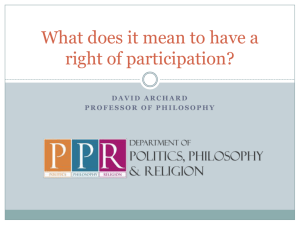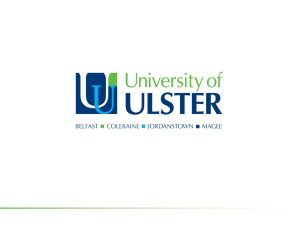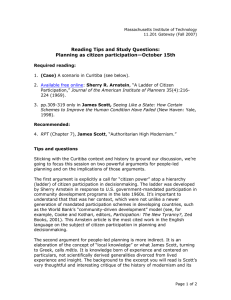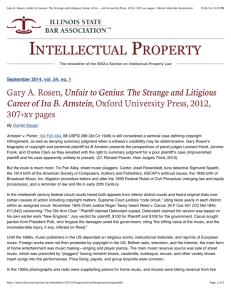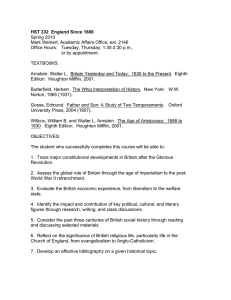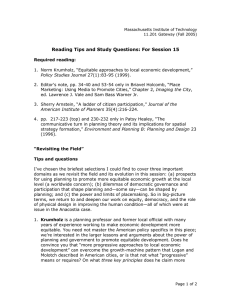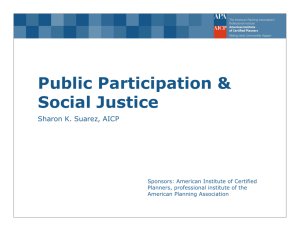11.201 Gateway: Planning Action Prof. Xavier de Souza Briggs
advertisement
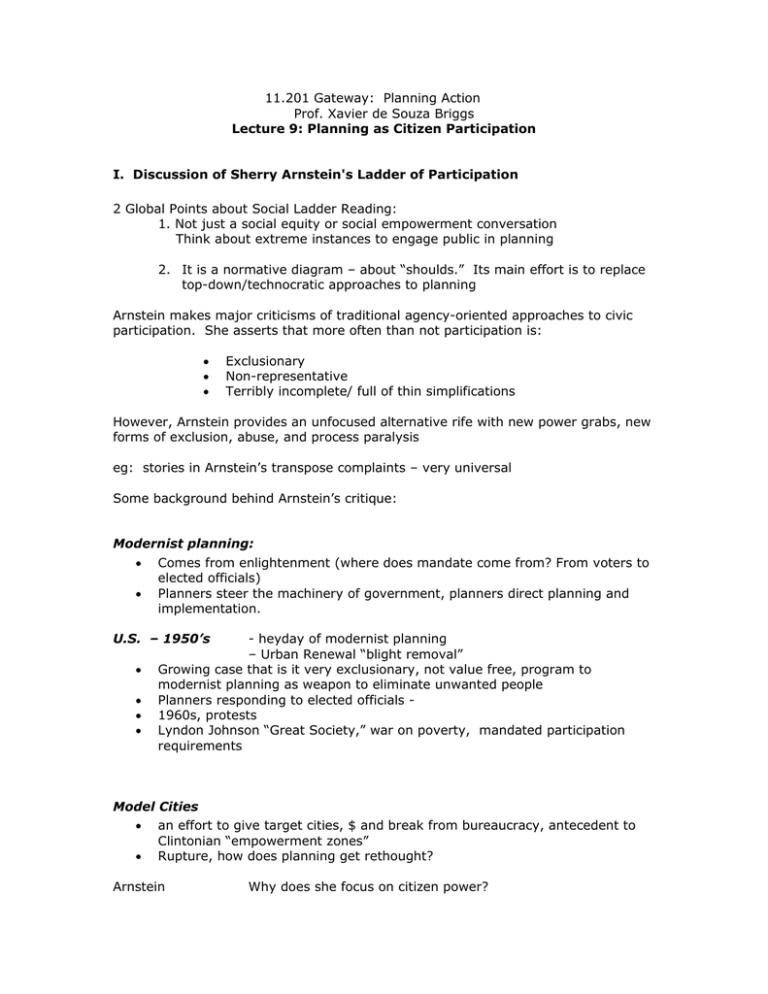
11.201 Gateway: Planning Action Prof. Xavier de Souza Briggs Lecture 9: Planning as Citizen Participation I. Discussion of Sherry Arnstein's Ladder of Participation 2 Global Points about Social Ladder Reading: 1. Not just a social equity or social empowerment conversation Think about extreme instances to engage public in planning 2. It is a normative diagram – about “shoulds.” Its main effort is to replace top-down/technocratic approaches to planning Arnstein makes major criticisms of traditional agency-oriented approaches to civic participation. She asserts that more often than not participation is: • • • Exclusionary Non-representative Terribly incomplete/ full of thin simplifications However, Arnstein provides an unfocused alternative rife with new power grabs, new forms of exclusion, abuse, and process paralysis eg: stories in Arnstein’s transpose complaints – very universal Some background behind Arnstein’s critique: Modernist planning: • • Comes from enlightenment (where does mandate come from? From voters to elected officials) Planners steer the machinery of government, planners direct planning and implementation. U.S. – 1950’s • • • • - heyday of modernist planning – Urban Renewal “blight removal” Growing case that is it very exclusionary, not value free, program to modernist planning as weapon to eliminate unwanted people Planners responding to elected officials 1960s, protests Lyndon Johnson “Great Society,” war on poverty, mandated participation requirements Model Cities • • an effort to give target cities, $ and break from bureaucracy, antecedent to Clintonian “empowerment zones” Rupture, how does planning get rethought? Arnstein Why does she focus on citizen power? Why participation = power A lot of participation forms are tokenism Instead, Participation should include: 1. Agenda setting (defining issues and stake holders) 2. Strategy making ( heart of planning) 3. Participatory design – how to make these most effective – being user-oriented is implicit part of Arnstein’s argument. Participatory design can limit impasse – structure can improve the caliber and product of conversations. A brief review of US federalism in relation to Arnsten: 3 levels: Federal State Local A. Arnstein calls improvements at the local level - “something closer to the people than city hall” 1. Organized at sub-local level (not everyone is able to do that) But cannot influence a pre-conceived plan 2. Tyranny from below: having organizations physically and socially closely linked has positive impacts 3. A legitimate popular mandate can lead to bad ideas, with no promise of successful outcome. What assures the quality of ideas? Arnstein’s ladder depends on the decision making power and the ability to borrow from city government. Arnstein didn’t write with the idea in mind that federal planning funding would evaporate. • • • • Channeling money into receivership – gain independence from larger decision makers Advising is not the same as deciding Broader range of ideas- wish lists versus analysis Balancing community input with different types of knowledge II. Who knows (expertise: metis and formal codified knowledge) Consider: Pressure politics Sources of accountability Why participate in the public” – advising versus deciding – rational for participating in the public – planning together (Psychological) Consultation is appreciated (procedural justice) (Political) taking public action imbued with a genuine public mandate (Practical) two heads can be better than one (contradiction – group think) Class participation in group exercise: 11.201, Gateway: Planning Action Prof. Xavier de Souza Briggs Lecture 9 Page 2 of 3 How do you set an agenda? How can you be mindful of priorities, brokering resources (but assuming that taking advantage of investments would hinge on utilizing particular funding streams) Where does the mandate for the public good come from? Short-term versus long term. How do you instill a value that you need a process? What is the organizing ethos within planning? How does it pay off? Building capacity and momentum. Does it all begin on day 1? What makes knowledge more useful? Don’t discriminate. What do we know about everyday needs? Intelligence gathering, open ended questions are very generative (of responses, informative), weekday, weekend, etc. What institutions are important to you. Stories of why you are in this condition? Several versions – how and why? Don’t have one type of conversations Civil society helping community movements move forward, government accomplishing projects (with community partnerships) Participation Assumptions and Realities Last assumption: Consider the known, the known unknowns, and unknown, unknowns. 11.201, Gateway: Planning Action Prof. Xavier de Souza Briggs Lecture 9 Page 3 of 3
